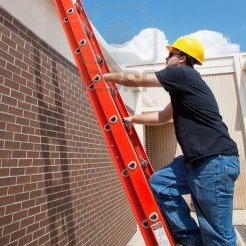
If you work on utility poles, do exterior painting, wash windows or any other job where ‘dealing with heights’ is a skill required to carry out daily functions then you have more than likely been grilled on safety tips for using a ladder. However, painters and carpenters are not the only ones who will ever be on a ladder. In fact, if you work a blue collar job you will use a ladder from time to time at your occupation. Consequently, it is important if you manage a group of workers and/or want to be informed that you brush up on rules for using a ladder correctly from time to time.
Selection
Attic ladder, Extension ladder, Hook ladder, Step ladder: Using a ladder correctly all begins with making the proper selection. How do you make the appropriate selection? The general rule is that the ladder user can safely reach no higher than 3 to 4 feet above the top of a step ladder. If you are stretching to reach further than that you are using too small of a step ladder. For single/extension ladders the general rule is the highest standing level is four rungs down from the top.
Also, keep note of the ANSI Duty Rating which is labeled on the ladder. It indicates the maximum safe load capacity (person and tools). Ladders are produced out of wood, aluminum and fiberglass. Fiberglass is considered not only the most durable but safe. Aluminum is also durable yet vulnerable near electricity.
Inspection
After picking the appropriate ladder for the job double check the ladder for:
• Cracks, splits, corrosion
• Steps/rungs free of oil/grease
• Steps/rungs firmly attached to side rails
• Moveable parts operate smoothly without binding
• Safety feet/base in good condition
• Ropes in good condition (if applicable)
These are all basic measures to make sure the ladder is safe to climb and only take a few minutes of your time yet ensure the safety of its use. If a ladder is ever found defective do not attempt to repair. Discard and purchase a new one.
Proper Use
The proper use of a ladder is broken down into three simple steps: location, ladder setup and climbing. Placing the ladder in a safe location essentially comes down to common sense. Make sure the base is stable, do not place a ladder in front of a door, never use metal ladders around electrical equipment, etc, etc.
Never set a ladder on boxes, barrels, or other unstable bases to gain height. Ladders are only to be used on a flat surface and when the base is uneven, wooden boards braced under the ladder can serve as a level.
The general rule is to angle the ladder 1 foot away from the wall at the base for every 4 feet of ladder length (i.e. 12 foot ladder is 3 feet from wall). If you plan to access the roof or another elevated location the ladder should always extend at least 3 feet above the roof/extended location. Securing the ladder at the top is always recommended yet if not an option always have someone ‘support’ the ladder at ground level, especially if ladder is 16 feet or longer.
When climbing a ladder never stand/work on the top three rungs of a single/extension ladder. For stepladders do not stand on the topcap, or first step. Always use the ‘Belt Buckle Rule’ when climbing a ladder including keeping at least three points of the body contact with the ladder (2 feet + 1 hand, or hips or chest).
